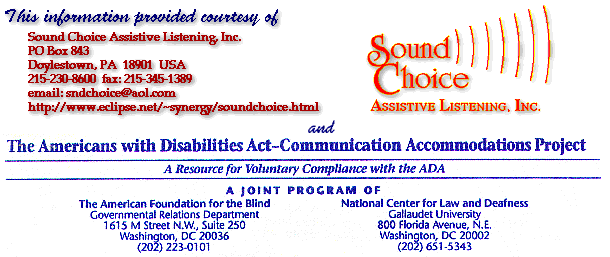
OBLIGATIONS OF THEATERS AND
LECTURE HALLS UNDER THE AMERICANS WITH DISABILITIES ACT OF
1990
You have asked for information about the obligations of a
theater or lecture hall under the Americans with
Disabilities Act (ADA), 42 U.S.C. 12101-12213.
Title III of the ADA applies to all
"places of public accommodation," including a "motion
picture house, theater, concert hall, stadium, or other
place of exhibition or entertainment." 28 C.F.R. 36.104. In
addition to the duty to remove structural barriers to
communication pursuant to 28 C.F.R. Section 36.304, places
of public accommodation are required to provide "effective
communication" to persons with disabilities:
(c) Effective communication.
A public accommodation shall furnish appropriate
auxiliary aids and services where necessary to ensure
effective communication with individuals with
disabilities.
28 C.F.R. 36.303. Places of public
accommodation must provide assistive listening systems,
interpreters and other auxiliary aids unless it would
constitute an "undue burden" or "fundamental alteration" of
their services. 28 C.F.R. Section 36.303(a).
Auxiliary aids and services
are defined to include:
Qualified interpreters, notetakers,
computer-aided transcription services, written materials,
assistive listening devices, assistive listening systems,
telephones compatible with hearing aids, closed caption
decoders, open and closed captioning, telecommunications
devices for deaf persons (TDD's) videotext displays, or
other effective methods of making aurally delivered
materials available to individuals with hearing
impairments.
28. C.F.R. 36.303(b)(1).
The appropriate auxiliary aid or
service will vary, depending on the context and the need of
the individual with disabilities. It would not be unusual to
find that a theater or other place of public accommodation
must provide several different types of auxiliary services.
For example, a qualified interpreter might be needed to
provide access for deaf individuals, while an assistive
listening system (such as a loop or FM transmitter or other
device) might also be needed to give effective access to the
amplification system for a hearing aid user who does not use
sign language. The auxiliary aid requirement is flexible,
and the place of public accommodation can choose among
various alternatives as long as the result is effective
communication for the hearing impaired customer. The U.S.
Department of Justice strongly encourages consultation with
persons of disabilities, to ascertain the services that will
meet their needs. 56 Fed. Reg. 35566 (July 26,
199l).
The regulation expressly defines a
"qualified interpreter" as follows:
'Qualified interpreter' means
an interpreter who is able to interpret effectively,
accurately and impartially both receptively and
expressively, using any necessary specialized
vocabulary.
28 C.F.R. 36.104. The definition
recognizes that the skill level needed for certain types of
communication may be higher than for other types of
communication. An interpreter who can provide "effective"
and "accurate" interpretation in a one-on-one conversation
may not be qualified to provide the highly skilled
interpreting needed for a theater production or other stage
event.
Please note that the regulation
expressly prohibits charging an additional fee or
"surcharge" for the provision of an interpreter or any
auxiliary aid or service.
A public accommodation may
not impose a surcharge on a particular individual with a
disability or any group of individuals with disabilities
to cover the costs of measures, such as the provision of
auxiliary aids, barrier removal . . . and reasonable
modifications . . . that are required to provide that
individual or group with the nondiscriminatory treatment
required by the Act or this part.
28 C.F.R. 36.301(c). However,
"reasonable, completely refundable" deposits are permissible
for the loan of assistive listening equipment. 56 Fed. Reg.
35564 (July 26, 1991).
Guidance about the scope of the
requirement to provide assistive listening systems is
available from the ADA guidelines for new construction. When
a theater is newly constructed or added on to or renovated,
it must comply with the Americans with Disabilities Act
Architectural Guidelines (ADAAG), which are published as
Appendix B to the Justice Department regulation for Title
III. Existing facilities must also remove architectural
barriers, if doing so would be readily
achievable.
Assembly areas with fixed seating
where audible communications are integral to the use of the
space must have a permanently installed assistive listening
system if they accommodate at least 50 persons, or if they
have audio amplification systems. ADAAG 4.1.3(19)(b). The
regulation states:
The minimum number of
receivers to be provided shall be equal to 4 percent of
the total number of seats, but in no case less than
two.
A listening system serving individual
fixed seats must be located within a 50 foot (15 m) viewing
distance of the stage or playing area and shall have a
complete view of the stage.
There are several types of listening
systems that may be appropriate. ADAAG A4.33.7 provides a
table and some guidance in summarizing the three principal
systems: induction loop transmitter; FM transmitter;
infrared transmitted. I have enclosed some additional
information about the different types of systems that may be
helpful. Please contact us if you need more specific
information about types and placement of assistive listening
systems.
Funded by a Grant
from the U.S. Department of Justice
|